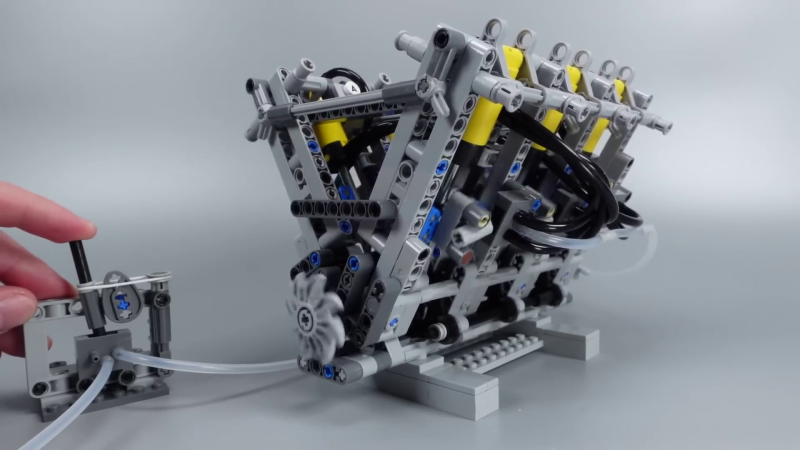When learning about the design of a machine or mechanism, reading and watching videos is certainly effective, but it’s hard to beat hands-on experimentation. In the video after the break, [Brick Technology] uses LEGO to gain some practical insight into the world of piston engine design, from single-cylinder all the way up to radial twelve-cylinder engines.
Using pneumatic cylinders from the LEGO Technic series, [Brick Technology] starts by getting the basics working with a single-cylinder design. Besides the fact that there are no fuel-air explosions involved, these pistons are also double-acting thanks to a valve mechanism that switches the pressurized side of the piston as it reaches the end of its stroke. After a couple of experiments, he settles on using a bank of six two liter soda bottles as a source of pressurized air.
 He also increased the performance of the LEGO cylinders by drilling out the ports and adding silicon oil for lubrication. In the initial prototypes, the cylinders also acted as connecting rods, tilting back and forth as the crankshaft rotates. After some testing, he discovered he could increase efficiency by constraining the cylinder with a slider mechanism and adding a separate connecting rod.
He also increased the performance of the LEGO cylinders by drilling out the ports and adding silicon oil for lubrication. In the initial prototypes, the cylinders also acted as connecting rods, tilting back and forth as the crankshaft rotates. After some testing, he discovered he could increase efficiency by constraining the cylinder with a slider mechanism and adding a separate connecting rod.
With the basics done, [Brick Technology] could start experimenting with engine arrangements and geometry. Inline two, three, and four cylinders and V2, V6, V8, and even R12 were all on the menu. He could also change crankshaft geometry to trade torque for RPM and vice versa, and build a starter motor, and torque generator.
Just like [Brick Technology]’s LEGO electronic drums and vortex machine, this video gives us a itch that can only be scratched by a few hundred LEGO pieces. For rapid prototyping of course.
















One has to be insane to pay for overpriced bits of ABS plastic when food prices are up 150-200% year to year and some foods became scarce because of economic hardship.
Ok now put this on a RC car with co2 tube :D
I remember building with pnumatic legos for hours as a kid. Built a car with air powered breaks too, although they were not very kind to the driver.
Nice build, double-acting as in 1 stroke while most ICE machines are 2 or 4 stroke engines.
Silicone is what lubricates things. Silicon is, in part, what microchips are made of.
If you want to hang out with fellow LEGO engine builders of all types, go to the TBLE server on Discord. I have engines my brother and I built in the early 1990s and they are powered with a hair dryer or the exhaust of a wet/dry vac – search Lazlo LEGO on youtube.
I’m impressed by how the V8 and radial engines SOUND right.
ive built several of these. my most successful was an inline 3 that worked with unmolded parts. a lot of these engines involves doing surgery on the valves and cylinders to bore out the inlets and provide better airflow. they are also notorious for breaking lego gears.
I have always wondered if it would be possible to build a functional “tri v”, as in, a 3 cylinder engine in a V configuration, like a V twin, but with a third cylinder, 120 apart radially, also at a compound angle to each other, like a tripod config. I’ve just never seen it done and I think it would look cool but I can’t imagine what the linkage would look like. It’s been stuck in my head for years to build a custom bike around such an engine.
That’s a W12 https://en.wikipedia.org/wiki/W12_engine
I don’t think that’s quite right: the cylinders of a W12 aren’t 120 degrees apart. It’d be a Y shape rather than a W, if I understood the post correctly.
Take a look at the Szekely SR3 aircraft engine from the 1920’s. I think that’s what you’re talking about. I’ve seen one in person, although it wasn’t identified correctly in the (kinda halfhearted) museum that it was in.
It looks like Bristol also made a three cylinder radial in the 1920’s. Almost everyone moved to 5, 7, and particularly 9, because they were almost free: you already had the crankcase and the diameter, so why not pack in as many pistons as you could fit, and get more power per unit weight?
Yes- this is ALMOST what I am thinking of. Except my thought is not only are they at that angle, but also another compound angle- so they stick out like the legs of a tripod stool.
That I’ve never seen done. I just think it would look cool.
You could do it by having the cylinder heads at the top, and the pistons connected to three crankshafts (one each) connected by bevel gears at each end. The three crankshafts would form a triangle, with the connecting rods connecting at the midpoint of each shaft. One of the shafts would extend to the rest of the drive train. The head would have three sets of valves and three spark plugs in close proximity.
I was flipping through the YouTubes the other night and found this video gem. I was verbally excited at the V6. I exploded at the 12c rotary.